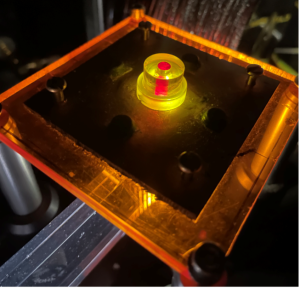 Elizabeth Pasatembou is a Research Postgraduate in the Department of Physics. In this blog post, she shares more about her research as part of QuEST (Centre for Quantum Engineering, Science and Technology at Imperial College London).
Elizabeth Pasatembou is a Research Postgraduate in the Department of Physics. In this blog post, she shares more about her research as part of QuEST (Centre for Quantum Engineering, Science and Technology at Imperial College London).
Can you tell us about your research area?
I am part of the Atom Interferometer Observatory and Network (AION) project [1, 2] which is supported by the UKRI Quantum Technologies for Fundamental Physics (QTFP) programme. The broader aim of the programme is to explore how quantum technologies can be utilised to advance our knowledge about the universe by exploring fundamental physics questions.
AION in particular aims to use quantum technology and atoms cooled down to extremely low temperatures to search for gravitational waves, in the previously unexplored mid-frequency band, and ultra-light dark matter as well as new fundamental interactions. We are developing a detector which uses quantum sensors in the form of atom interferometers. The detector will use strontium atoms cooled to the coldest temperatures possible (near absolute zero). The wave-like nature of the atoms allows us to put them in a superposition of states using lasers in the atom interferometer. This creates two different paths which atoms in two different states take. The two paths are made to come back together at the end of the atom interferometer and they interfere creating a pattern. The interference pattern is very sensitive to everything around it including gravity and therefore gravitational waves. By observing any changes to the interference pattern, we can infer whether a gravitational wave, for example, has passed through our detector. The project consists of various stages starting with a 10 m baseline detector currently being built in Oxford. Subsequent stages include a 100 m detector which will pave the way to a 1 km detector with the final stage being the development of a satellite-based detector.
The signals in the atom interferometers produced by gravitational waves and dark matter are extremely small and therefore every aspect of the technologies used needs to be fine tuned to detect this small changes at the quantum level. Therefore, the project is a collaboration between different universities in the UK each working on a different aspect of the detector. At Imperial [3] we are working towards improving the resolution of the detector by cooling down the atoms to as low temperatures as possible to increase the number of atoms that enter the interferometer. We are also working towards entangling atoms in a cavity allowing us to improve the resolution of the detector and the read the resulting pattern with greater resolution.
What led you to study this area?
Interestingly, my journey into this field of study was somewhat serendipitous. I initially chose physics because I had a strong desire to make sense of the world around me and make a meaningful impact. Early on, I recognised that physics serves as the foundation for many groundbreaking technologies.
During my undergraduate degree at UCL, I had the opportunity to delve into particle physics through a research project in my final year. This experience deepened my fascination with the subject, although I remained open to exploring other areas of physics. Consequently, I decided to take a slightly different path by pursuing a master’s degree in space science and engineering.
It was during this time that I stumbled upon the world of quantum technologies when I took an online course on quantum computing. This emerging field captured my imagination, offering a bridge between fundamental physics and practical applications. As I prepared to apply for PhD programs, I found myself torn between my passion for particle physics and newfound fascination with quantum technology.
Then, I encountered my current research project, which felt like the perfect convergence of my interests. This interdisciplinary endeavor, situated at the intersection of quantum technology, particle physics, and space physics, checked all the boxes for me. I eagerly embarked on this journey, and it quickly became clear that I had made the right choice.
Through this experience, I’ve come to realize the immense potential of quantum technologies and their revolutionary impact on people’s lives. My journey, has led me to a field where I can contribute to both the advancement of scientific knowledge and the development of groundbreaking technologies.
What are the main aims of your current research?
For the past two years, I have been working with the rest of the team at Imperial to build our lab from the ground up. Since this is a new project, a lot of my time was spent building the experiment. In the past few months our focus shifted from building the experiment (ultra-high vacuum system and laser and optics systems required to perform cold atom experiments in the lab) to actually testing the setup and performing experiments as well as analysing our results.
Our main aim at the moment is to develop and refine the technology further and to cool as many atoms as possible to the coldest temperatures possible in preparation for atom interferometry. The aim is to cool the atoms down to micro-Kelvin temperatures by trapping the atoms in what we call magneto-optical trap (MOTs). To achieve this we need very complicated laser and optics systems which can manipulate the motion of the atoms by targeting specific energy levels, reducing their motion and therefore cooling them down. All our findings and the refined techniques we use will be incorporated in the real detector which is currently under development in Oxford.
How could this research potentially benefit society?
Through our work with cold atoms, atom interferometers, and quantum sensors – technologies that we are actively developing in our lab – we are not only advancing our research objectives but also contributing to the ongoing development and improvement of these technologies. This, in turn, enhances their potential for various real-world applications
Cold atoms and atom interferometers have a lot of applications outside tests of fundamental physics. As they are a type of quantum sensor which can be used for gravitational field measurements, they have applications in geophysics and for exploring underground resources. Quantum sensors can also be used in Earth observation and monitor various environmental factors e.g. temperature, aiding climate change research. They can be used for improved navigation systems to provide more accurate positioning and navigation even where GPS signals are unavailable.
Atomic clocks are also based on cold atoms and use a lot of the techniques being developed in my research. These are extremely accurate clocks and are used for timekeeping as well as global communication and they are used in global navigation systems and telecommunications. Cold atoms can also be used as qubits in quantum computers which have the potential to revolutionise a lot of fields e.g. drug discovery and cryptography.
What are the next steps in your research? Are there any challenges ahead?
The next steps for the Imperial AION lab is to optimise the cooling of the atomic cloud. To do this, the cooling in the magneto-optical traps will be refined and the atoms will then be loaded into what we call an optical dipole trap to reduce their temperature even further. In an optical dipole trap, the atoms are trapped and manipulated using laser light. In this trap the atoms’s electric dipole moments interact with the electric field of the laser light and when the laser light is to the frequency of the atomic transition of the atoms, a force is experienced by the atoms which causes them to slow down even further.
After this, a technique called spin squeezing will be applied. This technique will enhance the sensitivity of the atom interferometer in the detector as it allows for a reduction of the quantum noise in the measurements. This is achieved by using an optical cavity (a set of mirrors) for the creation of quantum correlation between atoms.
All these techniques require very stable lasers and well aligned optics systems. Manipulating and entangling atoms with lasers is a complex process. It is already challenging enough in a controlled environment like the lab let alone taking these technologies out of the lab and incorporating them into the real detector.
[1] https://aion-project.web.cern.ch/
[2] L. Badurina, et al., “AION: An atom interferometer observatory and network,” Journal of Cosmology and Astroparticle Physics (2020), 10.1088/1475-7516/2020/05/011.
[3] https://www.hep.ph.ic.ac.uk/AION-Project/
 Dr Max Attwood is a UKRI Quantum Technology Career Development Fellow in the Department of Materials. His research focuses on developing organic materials for quantum technologies and a type of quantum sensor called the “maser”.
Dr Max Attwood is a UKRI Quantum Technology Career Development Fellow in the Department of Materials. His research focuses on developing organic materials for quantum technologies and a type of quantum sensor called the “maser”.
 A significant advantage of masers over contemporary high electron mobility transistor (HEMT) or superconducting interference device (SQUID) based microwave sensors is their remarkable signal-to-noise. To achieve low-noise figures, these devices require cryogenic refrigeration however, masers operate at room temperature.
A significant advantage of masers over contemporary high electron mobility transistor (HEMT) or superconducting interference device (SQUID) based microwave sensors is their remarkable signal-to-noise. To achieve low-noise figures, these devices require cryogenic refrigeration however, masers operate at room temperature.